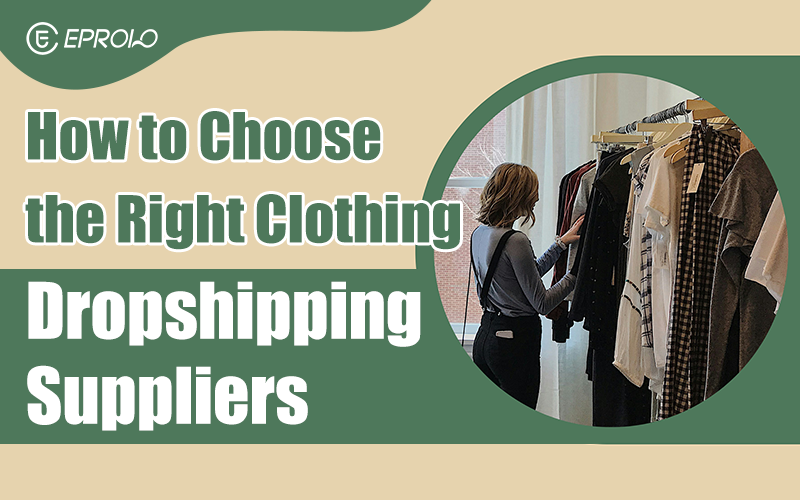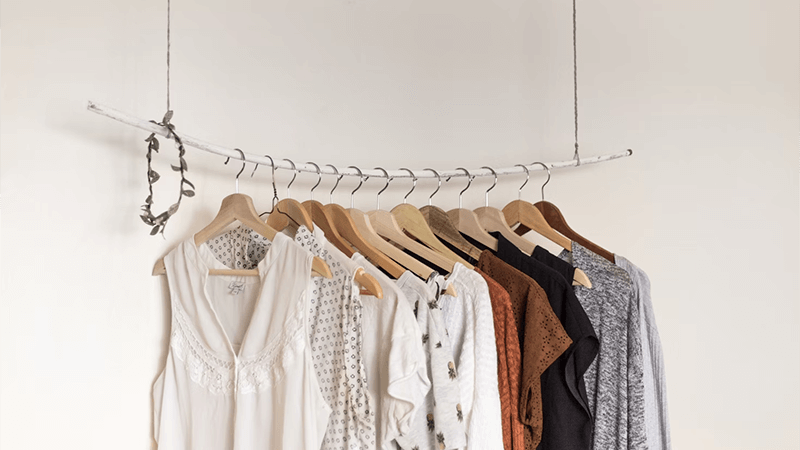Some dropshipping products just need to show up. Clothing? Clothing has to show up and impress.
Fashion is personal. It’s about how something fits, feels, moves, and makes someone feel about themselves. That’s why dropshipping in the clothing niche isn’t just about uploading a product and running an ad. It’s about building a customer experience—from first click to final return—that feels reliable, intentional, and branded.
In this guide, we’ll unpack what makes the clothing niche so different, what buyers actually care about, and how to choose a supplier who can help you scale, stand out, and build trust in a competitive market.

Page overview:
Why Clothing Dropshipping Is Different—and More Demanding
What Clothing Customers Really Care About
Dropshipping Clothing? Then You’re Building a Brand—Not Just a Store
How EPROLO Supports Brand-First Fashion Dropshippers
How to Vet a Clothing Supplier Before You Commit
Final Thoughts: A Good Supplier Doesn’t Just Ship Product—They Protect Your Brand
Why Clothing Dropshipping Is Different—and More Demanding
Selling clothes online isn’t like selling tech accessories or kitchen gadgets. Those categories are mostly about utility and price. Clothing is about identity.
Customers judge clothing by how it makes them look—and more importantly, how it makes them feel. That means expectations are higher, and mistakes cut deeper.
Here’s what makes clothing dropshipping more complex than it seems:
1. Fit is Non-Negotiable
No other niche depends on sizing accuracy the way fashion does. A 2cm difference between what’s listed and what’s delivered can be the difference between a “fits like a glove” review and a refund.
And unlike electronics or homeware, you can’t fix a sizing issue with instructions. If it doesn’t fit, it goes back.
2. Fabric Matters More than You Think
Your customers may never touch the product before buying—but they’ll remember exactly how it feels when they open the package. Thin, itchy, or stiff fabrics are immediate dealbreakers. Shoppers expect soft cotton, breathable blends, and a feel that matches the price point.
3. Style is Time-Sensitive
Trends shift constantly. A top that looks fresh one week might feel dated by the next. Dropshippers need the ability to test new styles quickly and drop slow sellers without long-term commitments.
4. Returns are Normal
Clothing returns are naturally high—even if you do everything right. Customers misjudge fit, order multiple sizes, or simply change their minds. That’s not failure. It’s built into the model. What matters is how you handle it.
What Clothing Customers Really Care About
You can’t pick the right supplier without knowing what your buyers care about. As a dropshipper, you choose suppliers for your customer. And they want something that feels curated, safe, and on-brand.
Let’s break it down:
Fit & Accuracy
Your customers trust you when they order based on the size chart. If the item arrives and doesn’t match what was promised, they don’t blame your supplier—they blame your brand. That’s why detailed sizing charts, consistent manufacturing, and real sample testing are essential.
Quality that Matches the Photos
Clothing buyers are visual shoppers. They notice color, texture, fabric thickness, and cut. If what they receive doesn’t match what they saw online, they’ll assume your store exaggerated or misrepresented the product—even if it was your supplier’s mistake.
Seamless Return Experience
Sometimes, even great items get sent back. When the return process is slow, confusing, or costly, buyers become critics. But when it’s clear, fast, and fair? They’re far more likely to try again.
A Store that Feels Like a Brand
Branded packaging, printed tags, custom labels—even a simple thank-you card—all show that someone actually cares about what was sent. Customers are far more likely to share, review, and recommend clothing purchases that feel personal, not generic.

Dropshipping Clothing? Then You’re Building a Brand—Not Just a Store
If you think of yourself as a reseller, your customer will too. But if you approach your store like a fashion label—with voice, consistency, and quality control—then buyers will come back for more.
Branded dropshipping doesn’t mean you need your own factory or a huge team. It means you build trust, piece by piece.
Here’s what that looks like as a dropshipper:
1. Product Curation
You don’t need to carry everything. You need to carry the right things—items that match your audience, pricing that makes sense for your market, and visuals that reflect your brand voice. Choose fewer, better pieces and make sure they match your style guide.
2. Consistent Delivery
If you’re building a brand, things like fit, shipping speed, and service can’t be all over the place. Slow delivery or out-of-stock items will lose customers fast. Your supplier has to keep up with the standards you promise.
3. Post-Purchase Confidence
A branded store doesn’t abandon the customer after checkout. That means clear shipping info, responsive service, and a returns process that respects the customer’s decision.
This is where many dropshippers fall apart—and where suppliers like EPROLO become a strategic advantage.
How EPROLO Supports Brand-First Fashion Dropshippers
EPROLO is more than a fulfillment platform. For fashion dropshippers, it’s a brand infrastructure.
Here’s how:
Easy Private Labeling & Branding Tools
With EPROLO, you can create a fully branded unboxing experience with:
- Custom clothing labels
- Hang tags with your brand logo
- Personalized thank-you inserts
- Branded packaging options
You don’t need to manufacture anything from scratch. You start with white-label products and customize them into your own line. That’s how dropshipping starts to feel like a fashion label—not just an online shop.
7-Day No-Questions-Asked Return Policy for Apparel
Returns are a brand moment. And EPROLO handles them with care.
The 7-day return policy for clothing allows customers to send back items that didn’t fit, weren’t what they expected, or simply changed their mind—without jumping through hoops.
This kind of policy builds buyer confidence, lowers your support burden, and strengthens your reputation in a category known for returns.
U.S., U.K., and China Warehouses for Faster Fulfillment
Speed matters in clothing. With fulfillment centers in multiple regions, EPROLO can reduce transit times and improve delivery consistency—especially when you’re selling in North America or Europe.
This makes it easier to set accurate delivery expectations and avoid refund requests due to delays.
Full Automation and Platform Integration
As your store grows, you can’t afford to manually manage orders or customer updates. EPROLO connects directly to platforms like Shopify and WooCommerce, syncing orders, tracking, and inventory in real time.
The result? Less operational stress, more time to focus on styling, marketing, and growing your customer base.
How to Vet a Clothing Supplier Before You Commit
Now that you know what to look for—fit accuracy, fulfillment reliability, branding options, return support—it’s time to test your short list.
Here’s how to do it the smart way:
Order Samples Like a Real Customer
Don’t just test your favorite item—order multiple SKUs in different sizes. Try them on. Compare the actual garment to the listed sizing. Note any inconsistencies in fabric, stitching, packaging, and presentation.
Track How Long It Takes from Order to Delivery
Time every step: from order confirmation, to packing, to courier handoff, to delivery. A 48-hour delay at the warehouse can throw off your shipping promise completely.
Review Their Pricing Structure Carefully
Ask about:
- Wholesale pricing tiers
- Shipping costs by region
- Handling or packaging fees
- Extra charges for customization
- Return processing fees (if any)
Get this in writing before listing anything.
Test Their Support Responsiveness
Message them with questions. Time their responses. Are they vague or clear? Are they responsive and honest—or just eager to get your business? Good communication early on prevents major issues later.
Final Thoughts: A Good Supplier Doesn’t Just Ship Product—They Protect Your Brand
In clothing, your customer experience begins long before unboxing and continues long after. You’re not just sending fabric. You’re sending a message: this is who we are.
If your supplier can’t support that message with:
- Consistent product quality
- Clear sizing and fit
- Flexible returns
- Brandable fulfillment
- Fast and traceable logistics
—then they’re not just costing you profit. They’re weakening your brand.
But with the right supplier, you don’t just stay afloat in a competitive niche. You build something lasting. You become more than a store. You become a fashion brand that customers recognize, trust, and recommend.







